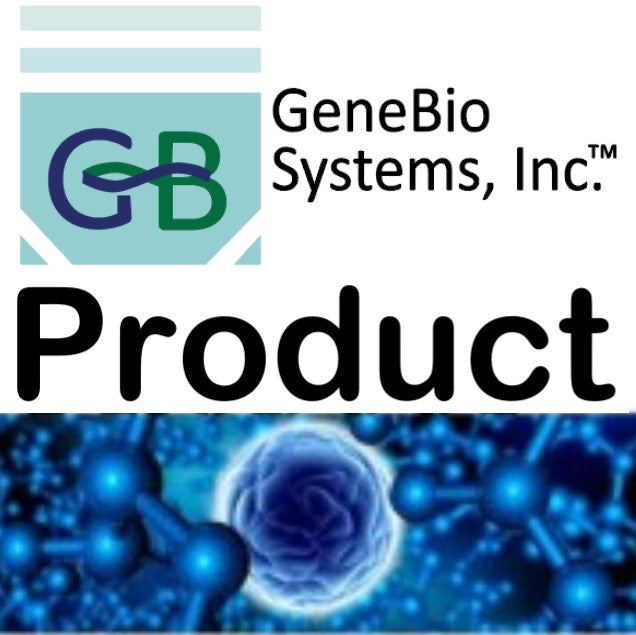Gene Bio Systems
Recombinant Rat Protein S100-A9(S100a9)
Recombinant Rat Protein S100-A9(S100a9)
SKU:CSB-EP020642RA
Couldn't load pickup availability
>Several Other Sizes Are Also Available. Please Inquire. Default Size: 200ug
Updated Date: Stock Protein updated on 20170405
Research areas: Immunology
Target / Protein: S100a9
Biologically active: Not Tested
Expression system: E.coli
Species of origin: Rattus norvegicus (Rat)
Delivery time: 3-7 business days
Uniprot ID: P50116
AA Sequence: AAKTGSQLERSISTIINVFHQYSRKYGHPDTLNKAEFKEMVNKDLPNFLKREKRNENLLRDIMEDLDTNQDNQLSFEECMMLMGKLIFACHEKLHENNPRGHDHSHGKGCGK
Tag info: N-terminal 6xHis-SUMO-tagged
Expression Region: 2-113aa
Protein length: Full Length
MW: 29 kDa
Alternative Name(s): Calgranulin-B Migration inhibitory factor-related protein 14 Short name:MRP-14 Short name:p14 Myeloid-related protein 14 S100 calcium-binding protein A9
Relevance: S100A9 is a calcium- and zinc-binding protein which plays a prominent role in the regulation of inflammatory processes and immune response. It can induce neutrophil chemotaxis, adhesion, can increase the bactericidal activity of neutrophils by promoting phagocytosis via activation of SYK, PI3K/AKT, and ERK1/2 and can induce degranulation of neutrophils by a MAPK-dependent mechanism. Predominantly found as calprotectin (S100A8/A9) which has a wide plethora of intra- and Extracellular domain functions. The intracellular functions include: facilitating leukocyte arachidonic acid trafficking and metabolism, modulation of the tubulin-dependent cytoskeleton during migration of phagocytes and activation of the neutrophilic NADPH-oxidase. Activates NADPH-oxidase by facilitating the enzyme complex assembly at the cell membrane, transferring arachidonic acid, an essential cofactor, to the enzyme complex and S100A8 contributes to the enzyme assembly by directly binding to NCF2/P67PHOX. The Extracellular domain functions involve proinfammatory, antimicrobial, oxidant-scavenging and apoptosis-inducing activities. Its proinflammatory activity includes recruitment of leukocytes, promotion of cytokine and chemokine production, and regulation of leukocyte adhesion and migration. Acts as an alarmin or a danger associated molecular pattern (DAMP) molecule and stimulates innate immune cells via binding to pattern recognition receptors such as Toll-like receptor 4 (TLR4) and receptor for advanced glycation endproducts (AGER). Binding to TLR4 and AGER activates the MAP-kinase and NF-kappa-B signaling pathways resulting in the amplification of the proinflammatory cascade. Has antimicrobial activity towards bacteria and fungi and exerts its antimicrobial activity probably via chelation of Zn2+ which is essential for microbial growth. Can induce cell death via autophagy and apoptosis and this occurs through the cross-talk of mitochondria and lysosomes via reactive oxygen species (ROS) and the process involves BNIP3. Can regulate neutrophil number and apoptosis by an anti-apoptotic effect; regulates cell survival via ITGAM/ITGB and TLR4 and a signaling mechanism involving MEK-ERK. Its role as an oxidant scavenger has a protective role in preventing exaggerated tissue damage by scavenging oxidants. The iNOS-S100A8/A9 transnitrosylase complex is proposed to direct selective inflammatory stimulus-dependent S-nitrosylation of multiple targets such as GAPDH, NXA5, EZR, MSN and VIM by recognizing a [IL]-x-C-x-x-[DE] motif (By similarity).
Reference: "Expression and cloning of migration inhibitory factor-related protein (MRP)8 and MRP14 in arthritis-susceptible rats."Imamichi T., Uchida I., Wahl S.M., McCartney-Francis N.Biochem. Biophys. Res. Commun. 194:819-825(1993)
Purity: Greater than 90% as determined by SDS-PAGE.
Storage: The shelf life is related to many factors, storage state, buffer ingredients, storage temperature and the stability of the protein itself. Generally, the shelf life of liquid form is 6 months at -20℃/-80℃. The shelf life of lyophilized form is 12 months at -20℃/-80℃.
Notes: Repeated freezing and thawing is not recommended. Store working aliquots at 4℃ for up to one week.


